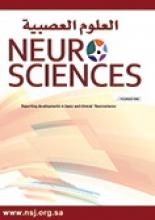Abstract
OBJECTIVE: To review the clinical, neuroimaging, cytogenetic, and biochemical studies obtained in 20 patients with different cerebellar structural abnormalities presenting at variable ages of onset with variable signs and symptoms.
METHODS: These patients visited the Clinical Genetics Department, National Research Center, Cairo, Egypt during the period from September 2002 to September 2003. All patients were subjected to complete personal and family history taking 3 generation family pedigree construction and full clinical examination, including complete eye evaluation. Metabolic screening, chromosomal examination and brain CT or MRI, or both, were also carried out.
RESULTS: Patients with cerebellar structural abnormalities were broadly divided into those with cerebellar hypoplasia (15 patients; 75%), cerebellar atrophy (3 patients; 15%) and cerebellar white matter abnormalities (2 patients; 10%). Further, cerebellar hypoplasia was subdivided into cerebello-vermal hypoplasia (4 patients; 20%), vermal-cerebellar hypoplasia (3 patients; 15%) and associated with involvement of other features such as brain stem (4 patients; 20%), posterior fossa (1 patient; 5%); and intracranial calcification (3 patients; 15%).
CONCLUSION: This study showed that the type of cerebellar structural abnormality is not the main determining factor of the clinical outcome, but rather the underlying etiology. A high incidence of mostly autosomal-recessive inheritance was diagnosed in 65% of the patients with cerebellar structural abnormalities. Nevertheless, the high rate of consanguinity (18 cases; 90%) with mean inbreeding coefficient of 0.05312 and the similarly affected sibs highlights the role of the autosomal recessive gene in our country.
- Copyright: © Neurosciences
Neurosciences is an Open Access journal and articles published are distributed under the terms of the Creative Commons Attribution-NonCommercial License (CC BY-NC). Readers may copy, distribute, and display the work for non-commercial purposes with the proper citation of the original work.






